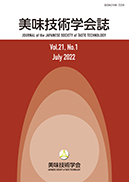Volume 21, Issue 1
Displaying 1-11 of 11 articles from this issue
- |<
- <
- 1
- >
- >|
-
2022Volume 21Issue 1 Pages 1-5
Published: July 31, 2022
Released on J-STAGE: August 25, 2023
Download PDF (590K)
-
2022Volume 21Issue 1 Pages 6-11
Published: July 31, 2022
Released on J-STAGE: August 25, 2023
Download PDF (1115K) -
2022Volume 21Issue 1 Pages 12-19
Published: July 31, 2022
Released on J-STAGE: August 25, 2023
Download PDF (1639K) -
2022Volume 21Issue 1 Pages 20-26
Published: July 31, 2022
Released on J-STAGE: August 25, 2023
Download PDF (1040K) -
2022Volume 21Issue 1 Pages 27-31
Published: July 31, 2022
Released on J-STAGE: August 25, 2023
Download PDF (916K) -
2022Volume 21Issue 1 Pages 32-37
Published: July 31, 2022
Released on J-STAGE: August 25, 2023
Download PDF (1028K)
-
2022Volume 21Issue 1 Pages 38-44
Published: July 31, 2022
Released on J-STAGE: August 25, 2023
Download PDF (838K) -
2022Volume 21Issue 1 Pages 45-56
Published: July 31, 2022
Released on J-STAGE: August 25, 2023
Download PDF (1546K)
-
2022Volume 21Issue 1 Pages 57-60
Published: July 31, 2022
Released on J-STAGE: August 25, 2023
Download PDF (1555K)
-
2022Volume 21Issue 1 Pages 61-62
Published: July 31, 2022
Released on J-STAGE: August 25, 2023
Download PDF (1210K) -
2022Volume 21Issue 1 Pages 63-64
Published: July 31, 2022
Released on J-STAGE: August 25, 2023
Download PDF (559K)
- |<
- <
- 1
- >
- >|
